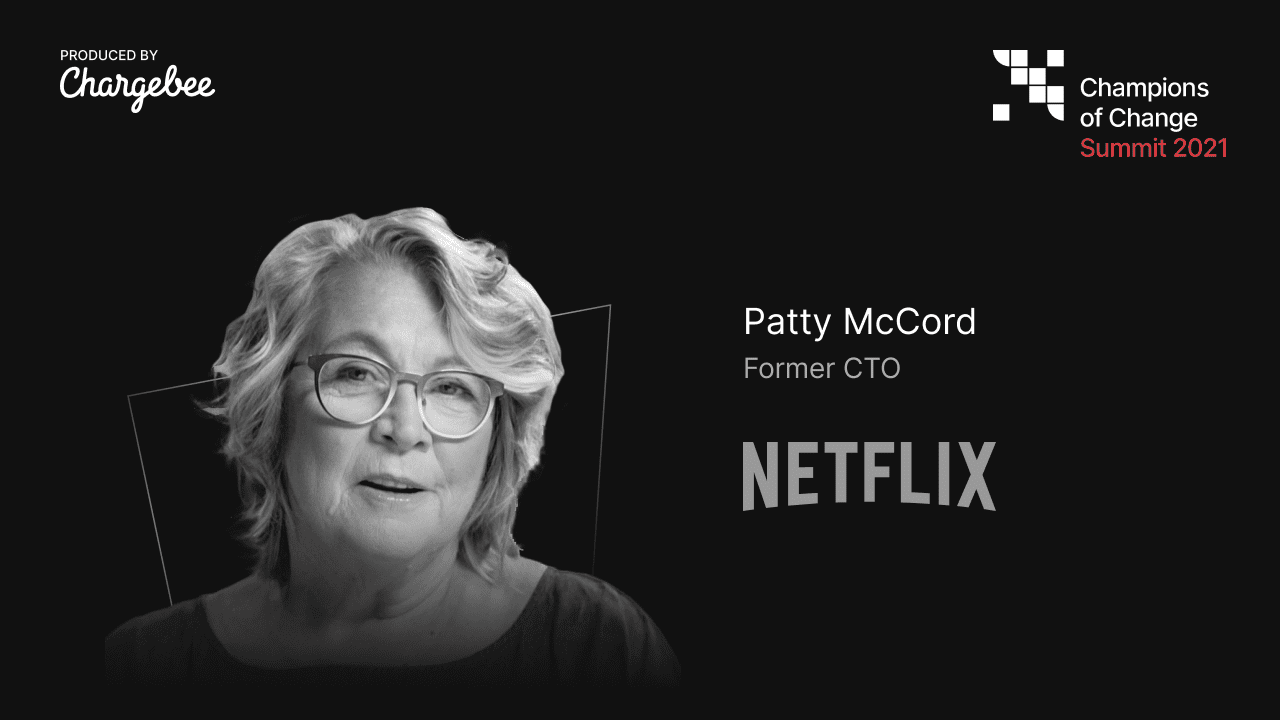“I think that the Champions of Change are also the ones that can’t see it and still embrace it.”
-Patty McCord Champions of Change Summit 2021
Chargebee’s 2021 Champion of Change Summit was packed with insightful conversations with some of the industry’s leading experts, including keynote speaker Patty McCord. Patty is highly regarded for her impactful career at Netflix, spanning 14 years as Chief Talent Officer and her contributions to the renowned Netflix Culture Deck.

In this session, Patty is joined by Chargebee’s Senior Director of Marketing, Vikram Bhaskaran. Together they discuss Patty’s impact at Netflix, the need for ever-evolving shifts in company culture, and how change is an unavoidable necessity.
Growing Pains
While the two touch on many vital nuances that come with understanding how to develop impactful and thriving company culture, at the core of the conversation is a focus on real people. It includes the people that are helping a company succeed from the inside – the employees – and the people that are helping from the outside – the customers.
Patty speaks about her experience with the development and re-evaluation of talent density at Netflix. She speaks candidly about being in a scenario that many can relate to in this industry. At the time, Netflix was still in the early startup stage and struggling financially. Multiple options were considered and exercised to deal with the challenges, but eventually, Patty had to lay off employees.
It’s never an easy scenario for companies to deal with but is sometimes necessary for long-term success. To come out of this in the best way possible, Patty wanted to ensure that she made a decision that kept customers at the forefront. “The criteria that I came up with was I had to say goodbye to anybody who wasn’t working directly on the product that would affect the customer.” This is so crucial when a company is dealing with something as tricky as employee layoffs. Taking the time to thoroughly assess which talent is most connected to your audience and is the most competent when it comes to solving your customer’s pain points is precisely what leaders must examine to make the best decisions.
But that’s not all. Patty took this a step further by helping team members understand how their efforts were directly connected to the customers and the company’s success.
“We taught everybody the business of the business. So we used to have this meeting when we were very small in the parking lot because we didn’t have a big enough room. And we would all gather together, and we would pass out a piece of paper with the executive dashboard in it. How much revenue we had, how much profit we were making, if any. What the cost of goods was, what the customer satisfaction rate was, what our growth rates were.
We taught people how the business works, and you know this as well as anybody else; subscription is a very different kind of business. It’s incredibly unique because people stay with you because it gets better, right? So the idea with subscription is the focus has to be on the delight of the customer. And so when you start thinking that’s the reason you’re in business and you start teaching people, that’s how our business works. ”
Giving employees the ability to truly understand how their daily efforts generate revenue and promote growth is key to an individual’s career journey. People feel successful when they can see the power of their work. It encourages them to keep doing their best work by keeping customer-centricity at the forefront.
Retiring the Five-Year Plan
When Vikram asks Patty what she thinks about investing in employee talent and up-skilling, her answer goes against the grain of what most consider a standard in the tech industry. “I’m going to say some controversial. I don’t think we can plan five years out. I think it’s a misnomer. And certainly, the last year has taught us that, huh? How many of you had a global pandemic on your to-do list?”
Patty certainly gives us all an interesting perspective that needs to be considered. Businesses around the world have had to drastically and quickly shift to adapt to the pandemic. And while nobody could have anticipated something of this magnitude happening we have all been learning how to adjust together. Part of that adjustment is working to improve how companies and individuals work together.
While many companies may ask employees where they see themselves in five years, it may be more beneficial to focus on equipping individuals with the ability to to simply do what they love. Patty believes that “my algorithm for success is: what you love to do, that you’re extraordinarily good at doing. So half of that is our responsibility as a company and half of it is yours. So at Netflix, we didn’t necessarily focus on developing each individual to be their best self. We focused on making sure that your best self was something that really mattered.”
This approach is at the core of the Netflix Culture Deck. Many other organizations have adopted it to help companies select the best talent while providing individuals with the opportunity to use their strongest skills to propel their careers and contribute to its overall success.
Cultural Shifts
A company’s culture should effortlessly embody and evidence the company’s most important values. Although, this isn’t something that’s finalized overnight. It’s something that many companies have found challenging and why they turn to experts like Patty for insight and education.
One of the most notable questions Vikram asks is, “What are some common misconceptions that people should be aware of when they’re trying to build this truly flat and global team culture? Are there any kinds of gaps that we should be aware of?”
Many companies have begun to make more effort to establish healthy company culture by focusing on values, diversity, inclusion, messaging, and more. Many of these same companies realize where they lack in company culture efforts and how there is a dire need for consistent evolution.
“I think it’s back to what I was saying about how culture is never static, that you have to morph your culture as you go across the world,” Patty states. She continues by speaking on what she had in mind when helping shape the company culture at Netflix.
“So what I had to do was say, if we want a culture of freedom and responsibility, then maybe I should get rid of a bunch of permissions. Maybe I should get rid of a bunch of tracking mechanisms. Maybe I should replace that with letting people make decisions on their own and then looking back and seeing did they have enough information to make the right decision. You then focusing on giving people enough information to make good decisions and hiring adults who are capable of doing that.”
There’s a strong underlying simplicity to Patty’s ideology. Instead of emphasizing creating something new, she leans on removing roadblocks and equipping people with what they need to do their best work. The best part about Patty’s approach is that any company can adopt it.
“Most of the innovative work I did at Netflix was not anything new. Most of the innovative work I did at Netflix was [when I] stopped doing things that don’t matter. I mean, think about that. It’s not starting, half of the time, it’s stopping.”
There’s no defined blueprint to developing a healthy and robust company culture. It’s an ongoing process that requires people to interrogate the static. If the unforeseen events of last year taught us anything, change is the only true constant. And if we’re willing to put in the effort to pivot, shift, start and stop, we can create a culture that benefits us all.
You can check out more insightful conversations from some real changemakers on the Champions of Change Podcast here.





